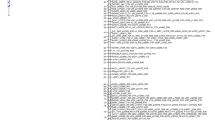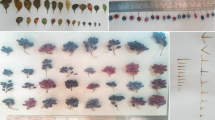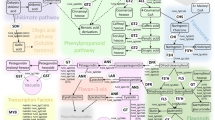Abstract
Introduction
Commercially, blackcurrants (Ribes nigrum L.) are grown mainly for processing, especially for juice production. They are valued for their high levels of polyphenols, especially anthocyanins, which contribute to their characteristic deep colour, but also as a good source of vitamin C. Recently, evidence has accrued that polyphenols, such as anthocyanins, may have specific human health benefits.
Objective
The aims of this study were to investigate the genetic control of polyphenols and other key juice processing traits in blackcurrants.
Methods
The levels, over 2 years, of vitamin C, citrate, malate, succinate, total organic acids, total anthocyanins and total phenolics together with 46 mainly polyphenol metabolites were measured in a blackcurrant biparental map** population. Quantitative trait loci (QTLs) for these traits were mapped onto a high-density SNP linkage map.
Results
At least one QTL was detected for each trait, with good consistency between the 2 years. Clusters of QTLs were found on each of the eight linkage groups (LG). For example, QTLs for the major anthocyanidin glucosides, delphinidin-3-O-glucoside and cyanidin-3-O-glucoside, co-localised with a QTL for total anthocyanin content on LG3 whereas the major anthocyanidin rutinosides, delphinidin-3-O-rutinoside and cyanidin-3-O-rutinoside, had QTLs on LG1 and LG2. Many of the QTLs explained a high proportion of the trait variation, with the most significant region, on LG3 at ~ 35 cM, explaining more than 60% of the variation in the coumaroylated metabolites, Cyanidin-coumaroyl-glucose, Delphinidin-coumaroyl-glucose, Kaempferol-coumaroyl-glucose and Myricetin-coumaroyl-glucose.
Conclusion
The identification of robust QTLs for key polyphenol classes and individual polyphenols in blackcurrant provides great potential for marker-assisted breeding for improved levels of key components.






Similar content being viewed by others
References
Allwood, J. W., Woznicki, T. L., Xu, Y. J., Foito, A., Aaby, K., Sungurtas, J., et al. (2019). Application of HPLC–PDA–MS metabolite profiling to investigate the effect of growth temperature and day length on blackcurrant fruit. Metabolomics,15, 12. https://doi.org/10.1007/s11306-018-1462-5.
Austin, M. B., & Noel, J. P. (2003). The chalcone synthase superfamily of type III polyketide synthases. Natural Product Reports,20, 79–110.
Brennan, R. M. (1996). Currants and gooseberries. In J. Janick & J. N. Moore (Eds.), Fruit breeding, Vol. II: Small fruits and vine crops (pp. 191–295). Wiley: New York.
Brennan, R. M., Jorgensen, L., Gordon, S. L., Loades, K., Hackett, C. A., & Russell, J. (2009). The development of a PCR-based marker linked to resistance to the blackcurrant gall mite (Cecidophyopsis ribis Acari: Eriophyidae). Theoretical and Applied Genetics,118, 205–212.
Brennan, R. M., Jorgensen, L., Hackett, C. A., Woodhead, M., Gordon, S. L., & Russell, J. (2008). The development of a genetic linkage map of blackcurrant (Ribes nigrum L.) and the identification of regions associated with key fruit quality and agronomic traits. Euphytica,161, 19–34.
Deighton, N., Brennan, R., Finn, C., & Davies, H. V. (2000). Antioxidant properties of domesticated and wild Rubus species. Journal of the Science of Food and Agriculture,80, 1307–1313.
Ghosh, D., & Scheepens, A. (2009). Vascular action of polyphenols. Molecular Nutrition and Food Research,53, 322–331.
Guo, W., Kong, E., & Meydani, M. (2009). Dietary polyphenols, inflammation, and cancer. Nutrition and Cancer,61, 807–810.
Hackett, C. A., Russell, J. R., Jorgensen, L., Gordon, S. L., & Brennan, R. M. (2010). Multi-environment QTL map** in blackcurrant (Ribes nigrum L.) using mixed models. Theoretical and Applied Genetics,121, 1483–1488.
Hancock, R. D., Walker, P. G., Pont, S. D. A., Marquis, N., Vivera, S., Gordon, S. L., et al. (2007). l-Ascorbic acid accumulation in fruit of Ribes nigrum occurs by in situ biosynthesis via the l-galactose pathway. Functional Plant Biology,34, 1080–1091.
Heiberg, N., Måge, F., & Haffner, K. (1992). Chemical composition of ten blackcurrant (Ribes nigrum) cultivars. Acta Agriculturae Scandinavica B,42, 251–254.
Hummer, K. E., & Barney, D. L. (2002). Currants. HortTechnology,12, 377–387.
Jaakola, L., Määttä, K., Pirttilä, A.-M., Törrönen, R., Kärenlamp, I. S., & Hohtola, A. (2002). Expression of genes involved in anthocyanin biosynthesis in relation to anthocyanin, proanthocyanidin, and flavonol levels during bilberry fruit development. Plant Physiology,130, 729–739.
Jarret, D. A., Morris, J., Cullen, D. W., Gordon, S. L., Verrall, S. R., Milne, L., et al. (2018). A transcript and metabolite atlas of blackcurrant fruit development highlights hormonal regulation and reveals the role of key transcription factors. Frontiers in Plant Science,9, 1235–1241.
Li, J., & Ji, L. (2005). Adjusting multiple testing in multilocus analyses using the eigenvalues of a correlation matrix. Heredity,95, 221–227.
Li, X.-G., Wang, X.-G., & Yu, Z.-Y. (2015). Cloning of an anthocyanidin synthase gene homolog from blackcurrant (Ribes nigrum L.) and its sexpression at different fruit stages. Genetic and Molecular Research,14(1), 2726–2734.
Lu, Y., Foo, L. Y., & Wong, H. (2002). Nigrumin-5-p-coumarate and nigrumin-5-ferulate, two unusual nitrile-containing metabolites from blackcurrant (Ribes nigrum) seed. Phytochemistry,59, 465–468.
Kahkonen, M. P., Heinamaki, J., Ollilainen, V., & Heinonen, M. (2003). Berry anthocyanins: Isolation, identification and antioxidant properties. Journal of the Science of Food and Agriculture,83, 1403–1411.
Macheix, J.-J., Fleuriet, A., & Billot, J. (1990). Fruit phenolics. Boca Raton, FL: CRC Press.
Mattila, P. H., Hellström, J., McDougall, G. J., Dobson, G., Pihlava, J.-M., Tiirikka, T., et al. (2011). Polyphenol and vitamin C contents in European commercial blackcurrant juice products. Food Chemistry,127, 1216–1223.
McDougall, G. J., Gordon, S., Brennan, R., & Stewart, D. (2005). Anthocyanin-flavanol condensation products from blackcurrant (Ribes nigrum L.). Journal of Agricultural and Food Chemistry,53, 7878–7885.
Nour, V., Trandafir, I., & Ionica, M. E. (2011). Ascorbic acid, anthocyanins, organic acids and mineral content of some black and red currant cultivars. Fruits,66, 353–362.
Nwankno, A. J., Gordon, S. L., Verrall, S. R., Brennan, R. M., & Hancock, R. D. (2012). Treatment with fungicides influences phytochemical quality of blackcurrant juice. Annals of Applied Biology,160, 86–96.
Rafique, M. Z., Carvalho, E., Stracke, R., Palmieri, L., Herrera, L., Feller, A., et al. (2016). Nonsense mutation inside anthocyanidin synthase gene controls pigmentation in yellow raspberry (Rubus idaeus L.). Frontiers in Plant Science,7, 1892. https://doi.org/10.3389/fpls.2016.01892.
Ramassamy, C. (2006). Emerging role of polyphenolic compounds in the treatment of neurodegenerative diseases: A review of their intracellular targets. European Journal of Pharmacology,545, 51–64.
Russell, J. R., Bayer, M., Booth, C., Cardle, L., Hackett, C. A., Hedley, P. E., et al. (2011). Identification, utilisation and map** of novel transcriptome-based markers from blackcurrant (Ribes nigrum). BMC Plant Biology,11, 147. https://doi.org/10.1186/1471-2229-11-147.
Russell, J. R., Hackett, C. A., Hedley, P. E., Liu, H., Milne, L., Bayer, M., et al. (2014). The use of genoty** by sequencing in blackcurrant (Ribes nigrum) - develo** high-resolution linkage maps in species without reference genome sequences. Molecular Breeding,33, 835–849.
Sigurdson, G. T., Tang, P. & Giusti, M. M. (2018). Cis–Trans configuration of coumaric acid acylation affects the spectral and colorimetric properties of anthocyanins. Molecules, 23, 598–604.
Slimestad, R., & Solheim, H. (2002). Anthocyanins from blackcurrants (Ribes nigrum L.). Journal of Agricultural and Food Chemistry,50, 3228–3231.
Sumner, L. W., Amberg, A., Barrett, D., Beale, M. H., Beger, R., Daykin, C. A., et al. (2007). Proposed minimum reporting standards for chemical analysis. Metabolomics,3(3), 211–221.
Tian, Y., Laaksonen, O., Haikonen, H., Vanag, A., Ejaz, H., Linderborg, K., et al. (2019). Compositional diversity among blackcurrant (Ribes nigrum) cultivars originating from European countries. Journal of Agricultural and Food Chemistry,67, 5621–5633.
Torronen, R., McDougall, G. J., Dobson, G., Stewart, D., Hellstrom, J., Mattila, P. H., et al. (2012). Fortification of blackcurrant juice with crowberry: Impact on polyphenol composition, urinary phenolic metabolites, and postprandial glycemic response in healthy subjects. Journal of Functional Foods,4, 746–756.
Vagiri, M., Ekholm, A., Öberg, E., Johansson, E., Andersson, S. C., & Rumpunen, K. (2013). Phenols and ascorbic acid in black currants (Ribes nigrum L.): Variation due to genotype, location and year. Journal of Agricultural and Food Chemistry,61, 9298–9306.
Van Ooijen, J.W. (2004). MapQTL® 5, Software for the map** of quantitative trait loci in experimental populations. Kyazma B.V., Wageningen, Netherlands.
Vepsäläinen, S., Koivisto, H., Pekkarinen, E., Mäkinen, P., Dobson, G., McDougall, G. J., et al. (2013). Anthocyanin-enriched bilberry and blackcurrant extracts modulate amyloid precursor protein processing and alleviate behavioral abnormalities in the APP/PS1 mouse model of Alzheimer's disease. Journal of Nutritional Biochemistry,24, 360–370.
Vvedenskaya, I. O., Rosen, R. T., Guido, J. E., Russell, D. J., Mills, K. A., & Vorsa, N. (2004). Characterization of flavonols in cranberry (Vaccinium macrocarpon) powder. Journal of Agricultural and Food Chemistry,52, 188–195.
Walker, P. G., Viola, R., Woodhead, M., Jorgensen, L., Gordon, S. L., Brennan, R. M., et al. (2010). Ascorbic acid content of blackcurrant fruit is influenced by both genetic and environmental factors. Functional Plant Science and Biotechnology,4(Special issue 1), 40–52.
Woznicki, T. L., Sønsteby, A., Aaby, K., Martinsen, B. K., Heide, O. M., Wold, A.-B., et al. (2017). Ascorbate pool, sugars and organic acids in black currant (Ribes nigrum L.) berries are strongly influenced by genotype and post-flowering temperature. Journal of the Science of Food and Agriculture,97, 1302–1309.
Zhang, Y., Seeram, N. P., Lee, R., Feng, L., & Heber, D. (2008). Isolation and Identification of strawberry phenolics with antioxidant and human cancer cell antiproliferative properties. Journal of Agricultural and Food Chemistry,56, 670–675.
Zheng, J., Yang, B., Tuomasjukka, S., Ou, S., & Kallio, H. (2009). Effects of latitude and weather conditions on contents of sugars, fruit acids, and ascorbic acid in black currant (Ribes nigrum L.) juice. Journal of Agricultural and Food Chemistry,57, 2977–2987.
Zhou, B., Wang, Y., Zhan, Y., Li, Y., & Kawabata, S. (2013). Chalcone synthase family genes have redundant roles in anthocyanin biosynthesis and in response to blue/UV-A light in turnip (Brassica rapa; Brassicaceae). American Journal of Botany,100, 2458–2467.
Acknowledgements
We acknowledge funding for this research from the Scottish Government Rural and Environment Science and Analytical Services Division (RESAS).
Author information
Authors and Affiliations
Contributions
All authors contributed to the study conception and design. Material preparation, data collection and analysis were performed by EK and IA. QTL map** and associated statistical analysis was carried out by CH. The first draft of the manuscript was written by GMcD and CH. All authors commented on various versions of the manuscript. All authors read and approved the final manuscript.
Corresponding author
Ethics declarations
Conflict of interest
The authors declare that they have no conflicts of interest.
Ethical approval
This article does not contain any studies with human participants or animals performed by any of the authors.
Additional information
Publisher's Note
Springer Nature remains neutral with regard to jurisdictional claims in published maps and institutional affiliations.
Electronic supplementary material
Below is the link to the electronic supplementary material.
Rights and permissions
About this article
Cite this article
Abreu, I.N., Brennan, R.M., Kanichukattu, E.N. et al. Quantitative trait loci map** of polyphenol metabolites in blackcurrant (Ribes nigrum L.). Metabolomics 16, 25 (2020). https://doi.org/10.1007/s11306-020-1647-6
Received:
Accepted:
Published:
DOI: https://doi.org/10.1007/s11306-020-1647-6




